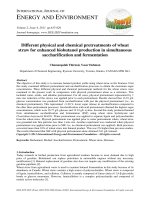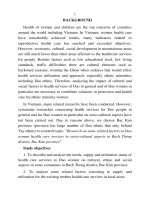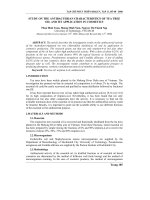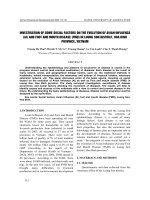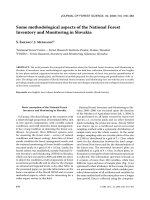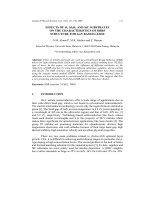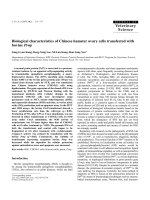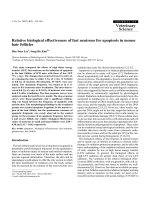Some biological characteristics of a species of lithocarpus fissus for large timber production in doan hung district phu tho province
Bạn đang xem bản rút gọn của tài liệu. Xem và tải ngay bản đầy đủ của tài liệu tại đây (7.07 MB, 49 trang )
ACKNOWLEDGEMENT
I would like to express my sincere gratitude to my supervisor Assoc. Prf. Bui The Doi
– vice president of the Vietnam National University of Forestry for the continuous support of
my thesis, for his patience, motivation, and immense knowledge. His guidance helped me in
all the time of research and writing of this study. I could not have imagined having a better
supervisor and mentor for my thesis. Thanks to cooperating between Vietnam National
University of Forestry and Colorado State University, I had an opportunity to acquire
knowledge and practice in the best condition.
Besides my supervisor, I would like to thank the board of directors and the officers of
the Central Northern Center of Forest Sciences for their insightful comments, enthusiasm and
encouragement, but also for supporting me on doing field work and accommodation during
my field trip. Without their precious support it would not be possible to conduct this thesis.
Last but not least, my sincere thanks also go to my family: my grandmothers, my
uncles, my sister and my brother for supporting me spiritually throughout writing this thesis
and my life in general.
1
ABSTRACT
This study was conducted to provide some biological characteristics of a species of
Lithocarpus fissus as the basis for timber production in Doan Hung district, Phu Tho province.
Several methods were used to collect and analyze data, namely field work, and data analysis.
The basic data analysis indicated that Lithocarpus fissus species played an important role in
species composition with pretty high results of important value (IV%) in all of the plots. This
species had the very impressive potential of regeneration; which contained more than 90% of
the good quality trees; and most of the regenerated trees were from seeds. However; they have
placed a restriction on growth due to the nutrient place competition. Therefore, it is necessary
to provide several suitable effects for the development of Lithocarpus fissus species. Mixed
plantation model, in general, had more advantages than pure (single – species) plantation
model. From analyzed results, the study provided some recommendations as well as suitable
suggestions for Lithocarpus fissus species in order to develop effectively and sustainably.
2
TABLE OF CONTENTS
ACKNOWLEDGEMENT
ABSTRACT
TABLE OF CONTENTS
LIST OF TABLE
LIST OF FIGURE AND PICTURE
ACRONYMS
1. INTRODUCTION ............................................................................................................. 1
2. LITERATURE REVIEW .................................................................................................. 3
2.1. Over the world ................................................................................................................ 3
2.1.1. Scientific name, classification ..................................................................................... 3
2.1.2. Morphological characteristics ..................................................................................... 3
2.1.3. Ecological characteristics............................................................................................ 4
2.2. In Vietnam ...................................................................................................................... 4
2.2.1. Scientific name, classification ..................................................................................... 5
2.2.2. Morphological characteristics ..................................................................................... 5
2.2.3. Ecological characteristics and distribution .................................................................. 5
2.3. Reviews of the studies ..................................................................................................... 6
2.4. Natural and socio – economic conditions of the study area .............................................. 6
2.4.1. Natural conditions ...................................................................................................... 6
2.4.2. The assessment of advantages and disadvantages ........................................................ 9
3. GOAL, OBJECTIVES, AND METHODS OF THE STUDY ........................................... 10
3.1. Goal .............................................................................................................................. 10
3.2. Specific objectives ........................................................................................................ 10
3.3. Methodology ................................................................................................................. 10
3
3.3.1. Fieldwork ................................................................................................................. 10
3.3.2. Data analysis ............................................................................................................ 11
4. RESULTS AND DISCUSSION ...................................................................................... 14
4.1. Some biological characteristics of a species of Lithocarpus fissus ................................. 14
4.1.1. Morphological characteristics ................................................................................... 14
4.1.2. The community structure analysis ............................................................................. 15
4.1.3. Natural regeneration ................................................................................................. 21
4.2. Assessing the plantation models in Doan Hung district, Phu Tho province .................... 29
5. DISCUSSION ................................................................................................................. 32
5.1. Review of the mature trees ............................................................................................ 32
5.2. Reviews of the naturally regenerated trees ..................................................................... 32
5.3. Review of the plantation models ................................................................................... 33
6. CONCLUSION AND RECOMMENDATION ................................................................ 35
6.1. Conclusion .................................................................................................................... 35
6.2. Shortcomings ................................................................................................................ 36
6.3. Recommendations ......................................................................................................... 36
REFERENCES
APPENDIX
4
LIST OF TABLE
Table 3.1: The species composition of the mature trees in Doan Hung district, Phu Tho
province ............................................................................................................................... 16
Table 3.2: The species composition‟s formula of the mature trees in the study area .............. 18
Table 3.3: The distribution of the plants based on the trees' height ....................................... 19
Table 3.4: The density of naturally regenerated trees ............................................................ 22
Table 3.5: The species composition index of naturally regenerated trees .............................. 23
Table 3.6: The species composition formula of the naturally regenerated trees in the study
area ...................................................................................................................................... 25
Table 3.7: The quality and the origin of the naturally regenerated trees in the study area ...... 26
Table 3.8: The distribution of naturally regenerated trees based on the tree‟s height ............. 27
Table 3.9: The growth of Lithocarpus fissus in 10 – year - old mixed plantation model ........ 29
Table 3.10: The growth of Lithocarpus fissus in 15 – year - old single species plantation
model ................................................................................................................................... 30
5
LIST OF FIGURE AND PICTURE
Figure 3.1: The distribution of the plants based on the tree‟s height ...................................................20
Figure 3.2: The distribution of Lithocarpus fissus species based on the tree‟s height ..........................21
Figure 3.3: The distribution of naturally regenerated trees based on the tree‟s height .........................28
Figure 3.4: The distribution of Lithocarpus fissus regenerated trees based on the tree‟s height ...........29
Picture 3.1: Trunk of Lithocarpus fissus species ................................................................................14
Picture 3.2: Flower of Lithocarpus fissus (source: ...........................................14
Picture 3.3: Leaf of Lithocarpus fissus species...................................................................................15
Picture 3.4: Cupule and seed of Lithocarpus fissus species (source: the Central Northern Center of
Forest Sciences) ................................................................................................................................15
6
ACRONYMS
MARD: Ministry of Agriculture and Rural Development
MONRE: Ministry of Natural Resources and Environment
MAI: mean annual increment
Ht: total height
Hb: bole height
D13: diameter at breast height
̅̅̅̅̅: mean of the diameter at breast height
̅̅̅: mean of the total height
N: density
: standard deviation
γ: coefficient of variation
Dcr: diameter of the crown
7
1. INTRODUCTION
Forest plays an important role in human life. It provides not only various products but
also the values of the ecological environment. In recent years, because of several disturbances,
such as over-exploitation, forestland transition, urbanization and weak management, the forest
resources have been dropped in both quality and quantity. In 1945, the total forest area of
Vietnam was about 14.3 million hectares with 43% of forest cover, and the primary forest
which had good quality was the capital component. By 1990, the total forest area massive
plunged to 9.3 million hectares with 28.4% of forest cover; the forest quality was very low.
Due to the protection and afforestation of society, in 2010, the total forest area increased to
13.95 million hectares which include 10.4 million hectares of the primary forest and 3.08
million hectares of the plantation; the forest cover rose to 39.5%. However, the forest quality
was dramatically meaningless and the sequestration is insignificant. Moreover, the
components of the forest were mostly fast growing wooding trees with low economic value,
which could not satisfy the need of production in recent and in the future (Ministry of
Agriculture and Rural Development, 2011).
Located in northern Vietnam, Phu Tho province is delimited by the provinces of
Tuyen Quang and Yen Bai in the north, Son La and Hoa Binh in the west, Ha Noi to the south,
and Ha Giang and Vinh Phuc to the east. According to the Ministry of Agriculture and Rural
Development (MARD), 2015, the province has an area of 353,294.93 hectares, including
64,097 hectares of natural forest, 121,703 hectares of plantation and the forest cover is 50.6%.
Although the forestry land is quite large, the forest quality is still low, mostly contain small
timber species. Facing to this situation, the problem is that how to develop the forest tree
species in sustainable ways.
Over 40 years of studying and experiment the native species for afforestation in various
regions, the planters have gained a wide range of positive results but also restrictions. The
1
main achievement was choosing 50 to 52 native species for large timber production as well as
smaller timber and non – timber forest products (the decision number 16/2005 of MARD).
About 28 species which contain 11 large timber species were studied in a systematic way and
50 species were planted for producing timber. Nearly 22 large timber species were planted in
a thousand hectare, however, only 18 species had. The main problems were that the group of
planning trees was various types, and the spearheaded species were not focused. Mostly, the
species were determined based on experience, and they did not have the studies which
provided orientation for the development. In order to improve the given problems, it is
necessary to study in a systematic way focusing on several spearheaded species. Many native
species have been included in the list of native tree species for reforestation, which was
introduced by MARD. However, most of them have not been studied about biological
characteristics.
Lithocarpus fissus is known as native and useful species which has wide distribution.
Their wood is very large and stiff, can be used to build house, create housewares or make
agricultural tools. Containing many advantages such as fast growth, high resistance ability,
and the ability of greatly natural regeneration is good, Lithocarpus fissus is potential species
to develop forest resources and enhance the economy of the country (Nguyen, 1999).
Although, there were several studies about Lithocarpus fissus, no study among them
related to the biological characteristics in Doan Hung district, Phu Tho province. Therefore,
the topic: “Some biological characteristics of a species of Lithocarpus fissus for large
timber production in Doan Hung district, Phu Tho province” was chosen as the topic of
the student graduation thesis.
2
2. LITERATURE REVIEW
2.1. Over the world
2.1.1. Scientific name, classification
The scientific name of studying species is Lithocarpus fissuss. This is large timber tree
which belongs to Fagaceae family. Besides, this species also has other scientific names:
Quercus fissa Champ. ex Benth, Pasania fissa (Champ. ex Benth.) Oerst, and Castanopsis
fissa (Champ. ex Benth.) Rehd. & Wils.
According to Bentham and Hooker (1862 – 1883), Fagaceae is not considered as an
independent taxon, the genus of Fagaceae are put on Cupuliferae. However, there are many
other opinions which regard Fagaceae as an independent family including 7 – 9 genus and
divide it to 2 -5 subfamily such as the systems of Milchior (1964), Menisky (1984), Takhtajan
A.L (1987), Soepadmo (1972). In 1996, Takhtajan A.L presented other classification system
which similar to opinions of Kupriantova (1962), putting Nothofagus genus out of Fagaceae.
In 2008, some botanists arranged Nothofagus genus into Nothofagaceae family (Judd, 2008).
2.1.2. Morphological characteristics
Huang Chengjiu et al (1999) describe Lithocarpus fissuss species as follows:
“Trees; bud scales, shoot apexes, and young leaf blades abaxially yellowish brown
puberulent and covered with rust-colored, small, lamellate, slightly adnate, waxy scalelike
trichomes. Branchlets red - purple, prominently angular. Leaves spirally arranged, yellowish
brown to gray; petiole 1–2.5 cm; leaf blade oblong to obovate - elliptic, very variable in sizes,
often 15–25 × 5–9 cm, thickly papery, base cuneate, margin from base to middle undulate and
crenate, apex acute, acuminate, or rounded; midvein raised adaxially; secondary veins 20 – 28
on each side of midvein or rarely fewer. Infructescence 8–18 cm; rachis glabrous. Cupule 1–
1.5 cm in diameter, irregularly 2- or 3(or 4)-valved with valves often curled, covered with
dark reddish brown mealy waxy scalelike trichomes, apex slightly cuspidate, wall 0.5–1 mm
3
thick; bracts scalelike, triangular to squarish, imbricate when young but mostly united and in
ring ribs with age. Nut globose to elliptic, 1.3–1.8 × 1.1–1.6 cm, apically brown-red
tomentose; scar basal, 4–7 mm in diameter”.
2.1.3. Ecological characteristics
There are about 900 species that belong to Fagaceae family over the world, mostly
distributed in the temperate zone of Northern Hemisphere, subtropical region, and tropical
region. The most distributed zone of Fagaceae is the Asia especially Vietnam which contain
216 species. The Africa and the Mediterranean are two places that contain the least species of
Fagaceae family - 2 species (Khamleck, 2004).
According to Paul C. F. Tam and D. A. Griffiths (1993), Lithocarpus fissuss species is
distributed in high elevation (from 700m to 1700m). This species usually grow in evergreen
forests which have moist soil conditions, a deep soil layer, heavy loam, soil which have pH
from 4.5 to 5. The lower limit temperature of this species is -5oC, they also can live in the area
that has annual precipitation range from 1000 mm to 2000 mm. The best locations for
Lithocarpus fissuss to grow are ridge areas with thick soil layer. The young trees can adapt to
shade tolerant. The mature trees, however, require fully light for their growth. The trees have
a high capacity of regeneration by bud and growing fast. For example, the 23 years old tree in
the secondary forest can have the height of 22 m and the diameter of 300 cm. In plantation
forest, their diameter can be 15 cm after 15 years. Lithocarpus fissuss species grow slower
after the period of 30 years old. They provide seeds after 7 – 8 years old, about 50 kg of seeds
each year in the best period. The seeds can be processed in 24 hours with the temperature of
80oC. They will germinate after 4 weeks.
2.2. In Vietnam
In Vietnam, the studies of Lithocarpus fissus species are still limitation. The authors
just focus on biological characteristics, distribution and several studies about planting
4
techniques. There are also some topics about selecting seeds and propagation, which can be
reviewed as follows:
2.2.1. Scientific name, classification
According to Chan LM, Huyen LT (2000), the scientific name of this species is
Castanopsis cerebrina, belong to Fagaceae family. There are about 7 genus with 600 species
over the world. Vietnam consists of 5 genus with about 120 species. However, the scientific
name of this specie is Lithocarpus fissuss. It is the most commonly scientific used name in
Vietnam (MARD, 2000).
2.2.2. Morphological characteristics
Hoang et al (2004) describe the morphological characteristics of Lithocarpus fissuss
species as follows:
“Trees up to 25 m high, up to 90 cm diameter. Trunk straight, young branches covered
with dense reddish brown, simple and stellate hairs. Leaves distichous, obovate, 12–20 by 4 –
8 cm, base cuneate, margin acutely and regularly serrate for 3/4 of the length towards the top,
apex acuminate, green above, reddish brown tomentose beneath, if mature almost glabrous,
venation pinnate, lateral veins 10 – 20 pairs, curved at the margin, prominent on lower surface.
Petiole 1 – 2 cm long, slightly tomentose. Male catkins 4 – 9 cm long, in branched panicles,
usually terminal. Perianth puberulous. Anthers small, filament slender. Pistillode small, styles
3, divergent. Female inflorescences 5 – 11 cm long. Cupule cup-shaped, 1.8 – 2.5 cm long,
1.6 – 2.2 cm diam., enclosing about 1/2 the seed, densely hairy inside, slightly tomentose
outside, scales acute, flat, arranged into many irregular bands, pedicel 4 – 5 mm long, solitary.
Nut narrowly conical, 2 – 2.5 by 1.4 –1.8 cm, tomentose, apex sometimes 3-angled”.
2.2.3. Ecological characteristics and distribution
The study of Hoang et al (2004) showed that Lithocarpus fissus species distribute
naturally in China (Southeast Yunnan), Indochina, the North of Thailand, Louang Namtha
5
province of Laos. They also grow naturally in many provinces of Vietnam such as Ha Tinh,
Nghe An, Thanh Hoa, Yen Bai, Tuyen Quang, Quang Ninh, Ha Bac and Ha Tay. Those are
light-demanding trees which grow on low hills or on the forest edge, altitude below 400m.
Their natural regeneration is good and their germination rate is very high, also in the nursery.
The flowering times of Lithocarpus fissuss species are from February to April, October, and
November. Their fruiting times are March to June, October to December.
2.3. Reviews of the studies
There are limited studies relating to Lithocarpus fissuss species in the world, which
mostly focused on classification, describing the morphological characteristics, and several
biological characteristics. Those studies indicated that this species has economic values,
which are advised to grow widely in the countries.
In Vietnam, until now, the studies about Lithocarpus fissuss species have focused on
the classification, describing the morphological characteristics, distribution. However, some
biological characteristic such as species composition and the distribution based on tree‟s
height have not been interested. Therefore, the topic “Some biological characteristics of a
species of Lithocarpus fissus for large timber production in Doan Hung district, Phu Tho
province” is very necessary.
2.4. Natural and socio – economic conditions of the study area
2.4.1. Natural conditions
2.4.1.1. Geographical location
Doan Hung is a rural district of Phu Tho province in the Northeast region of Vietnam.
According to data analysis from electronic communication website of Doan Hung district, it
has an area of 302.4 km2, including 27 communes and 1 town.
2.4.1.2. Topography
As reported by the Central Northern Center of Forest Sciences, Doan Hung has the
diverse topography which is divided by deep gorges and dense streams. For instance, there are
two main types of topography as follows:
6
- Type of Low Mountain: distributed in the central of the district, the topography in
here is quite low and less steep. The average high is 350 m while the average slope is 20 o.
- Type of hill: primarily distributed in the district, including separated hills or
connected hills. The average slope is 15 o. This type of topography is favorable for planting
industrial plants, fruit trees and long – term industrial plants. Besides, there are small valleys
between the hills which can be used to grow rice or short – term trees
In general, both types of topography are suitable for afforestation and planning long –
term industrial trees.
2.4.1.3. Geology, soil
The geological background of the study area is quite simple; mostly contain sediment
and metamorphic creating Oxisols on mica schist, clay schist, and Gnai. The weathered layer
is quite thick (more than 2 meters). Besides, the study area also has intermediate soil types,
slopes converge.
The land has mechanical composition from clay silt to silt; the land surface has high
soil porosity; the permeability and water retention are good; the pH ranges from 3.9 to 5.4; the
organic matter content is relatively high.
2.4.1.4. Climate, hydrology
Climate
According to the monitoring data of the weather station in Phu Tho province, Doan
Hung district has characteristics of tropical monsoon climate. There are two seasons in a year:
winter which is very dry and long, summer which is hot, moist and has a lot of rains.
- Temperature
The annual average temperature is 23.1oC. The dry season is from November to April
of the next year, December is the coldest month. The hot season starts in the month of May
and ends in October. The average temperature during this season is 28oC while their
maximum temperature is 41oC.
7
- Precipitation
The annual average precipitation is 1878 mm, rainfall mostly occurs in July, August,
September of which August has the highest amount of precipitation (322 mm on average),
January has the lowest amount of rainfall (31 mm on average). The annual average humidity
is 85%, maximum in March (92%), minimum in December (77%).
- Wind:
The northeast monsoon occurs from October to March of the next year. The wind
breeze and usually bring drizzling rains and cold weather. The southeast monsoon appears
from April to September; it breezes and carries a lot of vapor causing rainfalls.
In general, the climate of Doan Hung district is favorable for growing Lithocarpus
fissus species. However, because of the topography characteristics and the annual rainfall
regime, the cyclones, and the hail usually occurs affecting to plants.
Hydrology
Doan Hung district has two rivers: Lo river and Chay river. Besides, the study area has
dense canal and stream systems which are favorable for transportation and irrigation.
In recent years, Doan Hung district actively invested for exploiting natural water
resources in irrigation works and reservoirs. However, the natural forest area is limited and
the plantation forest just grows one type of tree species. Therefore, the delivery in streams is
unstable, cannot meet the demand of providing water for agriculture and forestry production.
Many drought years caused damage to forestry production.
2.4.1.5. Flora
As the central region of forestry in the northern, located between two forestry
productions areas - northwest and northeast, Doan Hung district contained 780 plant species
of 477 genus which belong to 120 families. There were many valuable wooding tree species
such as Erythrophloeum fordii, Dipterocarpus retusus, Amoors gigantea, Ormosia, M.
faveolata, some species of Fagaceae family and some species of bamboo. Some herbs species
8
occurred in here such as Gynochthodes officinalis, Homalomena occulta… Many species of
Arecaceae presented like Elaeis guineensis, Calamus armarus Lour.
Because of exploitation and the tradition of shifting cultivation, most of the rest are
poor secondary forests, forest restoration after cultivation. A lot of rare native species are in
danger of extinction.
Thanks to the efforts of the authorities and research agencies, in recent years, Doan Hung
district has recovered significant forest areas by regeneration solution, rehabilitation, and
afforestation. Currently, many stands which belong to IIIa1, IIIa2, IIa, IIb forests are protected.
According to the assessment of specialized agencies, the natural resilience in the study
area has dramatic potential if the natural regeneration could be combined with the artificial
regeneration and the suitable silvicultural techniques.
2.4.2. The assessment of advantages and disadvantages
2.4.2.1. Advantages
- This is the area where has many researching activities, experiment, science and
technology transfer in the forestry sector lead to receiving many investments from the
government.
- The conditions of climate, topography, the soil in the study area are favorable for
developing Lithocarpus fissus species.
- The area of forestry land is large, generally, has good soil quality; the soil still has
characteristics of forestry land; many areas have thick soil layer and high humus convenient
for the development of forestry production in the district.
2.4.2.2.Disadvantages
- Some remote communes have steep terrain lead to the difficulty of construction,
management, and protection, as well as the implementation of forestry production activities in
the study area.
- The climate of the district has some disadvantages such as frost, the wind, dry
months which affect to forestry production activities.
9
3. GOAL, OBJECTIVES, AND METHODS OF THE STUDY
3.1. Goal
To provide some biological and ecological characteristics of a species of Lithocarpus
fissus as the basic for large timber production in Doan Hung district, Phu Tho province.
3.2. Specific objectives
- To determine the biological and ecological characteristics of a species of Lithocarpus fissus
- To compare the different plantation models in study area
- To propose some suggestions to develop the species for large timber production
3.3. Methodology
3.3.1. Fieldwork
3.3.1.1. Method for morphological characteristics study
The morphological characteristics of a species of Lithocarpus fissus are described directly
through the representative objectives. The results are then compared to the data sources.
3.3.1.2. Species composition and regeneration study method
At the primary forest which has relatively concentrated distribution of Lithocarpus
fissus species, set up three particular plots (the plots must be representative of site condition,
slope direction, slope, Lithocarpus fissus density). Each plot has an area of 2500 m2 (50 m in
length and 50 m in width). In sample plots, collect the following data:
- For the mature trees (D1.3 > 6 cm): in the plots, classify the name of species,
investigate the growth indicators (diameter at breast height: D 1.3 – cm, total height: Ht – m,
crown diameter: Dcr – m, under canopy height: Hb – m), forest density, trees quality (good,
average, bad). The tool for measuring diameter is tape measure and for collecting height data
is Blume - Leiss
- For the regenerated trees (D1.3 < 6 cm): in each sample plots, establish 5 square subplots (5 m x 5 m), 4 sub-plots in 4 corners and 1 sub-plot in the center. Identify the name of
10
species, trees density, total height, trees quality (good, average, bad), the origination of
regenerated trees (seed, bud). The total heights of trees are measured by tape measure.
For the plantation forest, set up three plots (each plot has an area of 1000 m2 – 40 m x
25 m) for mix plantation and the same for single species plantation. Repeat all of measuring
50m
steps as primary forest.
50m
5m
5m
Figure 1: The plot sample of the primary forest
40m
25m
2m
2m
3.3.2. Data analysis
Figure 2: The plot sample of the plantation forest
The mean annual increment (MAI):
According to West (2009), MAI is average rate of production (of wood, biomass, basal
area, etc.) to any particular age of a stand
MAI =
11
Y(t): yield at time t
t: the age of species at a measuring time
The coefficient of variation
The coefficient of variation was calculated using Forkman‟s method (2009).
γ=
γ: coefficient of variation
: Standard deviation
µ: mean of investigated factor
The quality of species:
N% =
x 100
N%: the percentage of trees based on quality level
n: number of trees based on quality level
N: total number of investigated trees
The density of species:
N/ha =
N: density of species per one hectare
n: number of trees in the plot (for mature trees) or the sub – plot for (regeneration trees)
Splot: the area of plot or the total area of all sub – plots in the plot (m2)
The species composition
- For the tree stratum
The composition proportion of tree species is calculated by method of Vu (1984).
IV% =
IV%: the composition proportion (important value) of the species
N%: density of tree in the plot
12
G%: % by total basal area of such species in the forest community
According to Thai (1978), the species which have IV > 5% are significant ecological
species in the community. The species which take part in species composition must have
higher important value than the average important value of all species in the community. A
group which has less than 10 species and its important value is more than or equal to 40% can
be considered as a dominant group, and the community would be determined based on those
species.
- For the regeneration
Ki =
x 10
Ki: the species composition coefficient of a species of i
Ni: the number of a species of i
N: the total number of investigated trees
13
4. RESULTS AND DISCUSSION
4.1. Some biological characteristics of a species of Lithocarpus fissus
4.1.1. Morphological characteristics
The investigated results in Doan Hung district, Phu Tho province illustrates some
morphological characteristics of study species as follows:
Lithocarpus fissus is medium – sized
timber species; the length varies around 17
– 23 m; the diameter can reach to 80 cm.
Their stumps have small buttress. Their
trunk is straight; young branches are
covered with black – brown hairs. The
bark has light gray color; 3 – 5 mm thick.
Picture 3.1: Trunk of Lithocarpus fissus species
Flower
unisexual,
catkins
4
–
8
monoecious.
cm
long.
Male
Female
inflorescences 5 – 10 cm long. Anthers
small, filament slender.
Picture 3.2: Flower of Lithocarpus fissus (source:
/>
14
Leaves simple, oblanceolate, and alternate.
Leaf blade is 12 – 18 cm long, 4 – 8 cm
wide; margin serrate for 3/4 of the length
towards the top; apex acuminate; base
cuneate; petiole is 1.5 – 2 cm long,
tomentose. The colors between two blades
are dramatically different; the upper blade
is green while the below side is covered
with dark – brown hairs
Picture 3.3: Leaf of Lithocarpus
fissus species
Cupule is cup – shaped; 1.7 – 1.8 cm in
diameter, embracing 1/2 – 2/3 the seed;
hairy inside; tomentose outside. There are
some unevenly distributed scales in the
cupule. The nut is conical – shaped; 2.5 –
3 cm long; 1.5 – 1.8 cm in diameter; easy
Picture 3.4: Cupule and seed of Lithocarpus
fissus species (source: the Central Northern
Center of Forest Sciences)
to be detached from cupule
4.1.2. The community structure analysis
The community structure is silvicultural characteristics of a stand including species
composition, forest structure, distribution of tree based on diameter or height and some other
important characteristics. They are the basis for assessing the bio – ecological stability of
15
stands; and from that could provide some suitable solutions to enhance productivity as well as
promote the forest sustainable development. The study only assessed species composition and
forest structure.
4.1.2.1. Species composition
Species composition is an important indicator, which refers to the contribution of each
plant species in the forming of the plant community. Based on this indicator, people can
understand the forest sustainability level, the forest stability, and the forest biodiversity. The
species diversity illustrates the sustainability and the ability to resistant to the adverse
conditions of the environment in order to maintain the balance of forest ecosystems. The more
complex species composition is, the more sustainable and balanced the forest gets. In order to
illustrate the percentage of participation of species in the community, the study determined
the species composition by IV% (Important Value) method. Species composition is generally
expressed as a percent so that all species components add up to 100%.The more IV% value
species has, the more important in the community species is. The study results of species
composition in natural forest which has Lithocarpus fissus was described in tables 3.1 and 3.2:
Table 3.1: The species composition of the mature trees in Doan Hung district, Phu Tho
province
Number
Plot
No.
Specific name
of trees
per plot
̅̅̅̅̅
̅̅̅
∑Gi
∑Ni
IV
(cm)
(m)
(%)
(%)
(%)
1
Lithocarpus fissus
89
15.0
12.6
62.8
53.3
58.05
2
Erythrophloeum fordii
11
14.7
10.4
7.9
6.6
7.25
3
Lithocarpus corneus
11
14.1
11.2
6.7
6.6
6.65
Plot
4
Gironniera subaequalis
15
8.4
6.8
2.9
9
5.95
-1
5
Ormosia balansae
7
12.5
12.4
3.5
4.2
3.85
6
Pygeum arboreum
3
17.7
13.7
2.8
1.8
2.3
7
Engelhardtia roxburghiana
2
24.0
14.5
3.1
1.2
2.15
8
Elaeocarpus dubius
5
14.0
10.2
3.3
3
1.55
16
Plot
-2
Plot
-3
9
Cinnamomum bejolghota
3
11.5
8
1.2
1.8
1.5
10
Garcinia cambogia
2
16.7
10
1.5
1.2
1.35
11
Sp1
2
12.6
9
1.0
1.2
1.1
12
Knema globularia
2
10.5
7.5
0.7
1.2
0.95
13
Quercus platycalyx
2
8.7
10
0.4
1.2
0.8
14
Symplocos laurina
2
7.6
8
0.3
1.2
0.75
15
Artocarpus chaplasha
2
7.6
7.5
0.3
1.2
0.75
16
Calophyllum tetrapterum
1
14.0
13
0.5
0.6
0.55
17
Glycosmis Citrifolia
1
8.9
8
0.2
0.6
0.4
18
Lindera glauca
1
7.6
8
0.2
0.6
0.4
19
Syzygium cumini
1
8.0
6
0.2
0.6
0.4
20
Rauvolfia Verticillata
1
6.0
8
0.1
0.6
0.35
21
Sp2
1
6.7
8
0.1
0.6
0.35
22
Phyllanthus urinaria
1
6.0
7
0.1
0.6
0.35
23
Alphonsea monogyna
1
6.7
7
0.1
0.6
0.35
24
Canarium album
1
7.3
7
0.1
0.6
0.35
1
Lithocarpus fissus
49
13.6
14.1
29,0
27.1
28.0
2
Ormosia balansae
27
17.3
17
24,2
14.9
19.6
3
Gironniera subaequalis
28
8.6
7.9
6,2
15.5
10.8
4
Erythrophloeum fordii
17
13.2
13.1
9,1
9.4
9.2
5
Lithocarpus ducampii
14
15.3
14.2
9,6
7.7
8.7
6
Sp4
13
12.1
11.2
6,4
7.2
6.8
7
Elaeocarpus dubius
7
8.3
9.4
1,4
3.9
2.6
8
Cinnamomum bejolghota
3
22.8
17.7
3,4
1.7
2.5
9
Sp1
4
15.6
15.8
2,8
2.2
2.5
10
Knema globularia
5
11.2
10
2,1
2.8
2.4
11
Cinnamomum camphora
3
19.3
16.7
3
1.7
2.3
12
Sp3
4
10.9
10.8
1,4
2.2
1.8
13
Cinnadenia paniculata
3
7.5
9.3
0,5
1.7
1.1
14
Sp2
3
7.1
8.7
0,4
1.7
1.0
15
Sp5
1
15.8
16
0.7
0.6
0.6
1
Lithocarpus fissus
11
32.8
20.7
30.4
7
18.7
2
Ormosia balansae
16
19.5
17.8
15.7
10.1
12.9
3
Quercus platycalyx
17
12.5
13.3
7.6
10.8
9.2
17
4
Erythrophloeum fordii
13
17
14.2
10.1
8.2
9.2
5
Garcinia cambogia
19
9.2
9.4
4
12
8.0
6
Symplocos laurina
14
9.7
11.9
3.4
8.9
6.1
7
Elaeocarpus dubius
8
16.9
17.1
5.5
5.1
5.3
8
Cinnadenia paniculata
10
10.7
11.8
3.5
6.3
4.9
9
Castanopsis indica
4
28.4
16.8
4.2
2.5
3.3
10
Pygeum arboreum
4
18.5
16.5
3.6
2.5
3.0
11
Gironniera subaequalis
6
10.9
9.3
1.8
3.8
2.8
12
Cinnamomum bejolghota
6
10.3
11.3
1.6
3.8
2.7
13
Canarium album
6
7.7
8.2
0.8
3.8
2.3
14
Aidia pycnantha
5
8.6
10
0.9
3.2
2.0
15
Alphonsea monogyna
4
7.1
8.3
0.5
2.5
1.5
16
Castanopsis indica
2
17.6
15.5
1.6
1.3
1.4
17
Aphanamixis grandiflora
3
7.2
9.7
0.4
1.9
1.1
18
Lythocarpus corneus
1
19.6
21
0.9
0.6
0.8
19
Mischocarpus sundaicus
2
8.6
9
0.3
1.3
0.8
20
Knema globularia
1
18.9
18
0.8
0.6
0.7
21
Sp4
1
19.3
18
0.9
0.6
0.7
22
Litchi chinensis
1
16.8
19
0.7
0.6
0.6
23
Sp1
1
14.3
15
0.5
0.6
0.6
24
Sp2
1
8.3
12
0.2
0.6
0.4
25
Sp3
1
9.1
12
0.2
0.6
0.4
26
Vernicia montana
1
8
7
0.1
0.6
0.4
Table 3.2: The species composition’s formula of the mature trees in the study area
Plot
Species composition
Plot 1
58.05 Lf + 7.25 Ef + 6.65 Lc + 5.95 Gs + 22.1 Os (20 species)
Plot 2
Plot 3
28.0 Lf + 19.6 Ob + 10.8 Gs + 9.2 Ef + 8.7 Ld + 6.8 Sp4
+ 16.9 Os (9 species)
18.7 Lf + 12.9 Ob + 9.2 Qp + 9.2 Ef + 8.0 Gc + 6.1 Sl + 5.3 Ed +
30.6 Os (18 species)
18
Total number
of species
24
15
25

